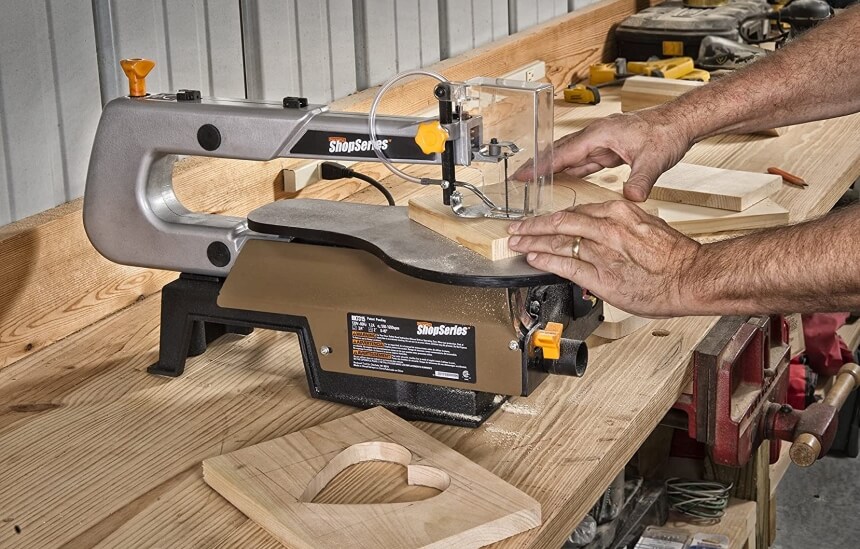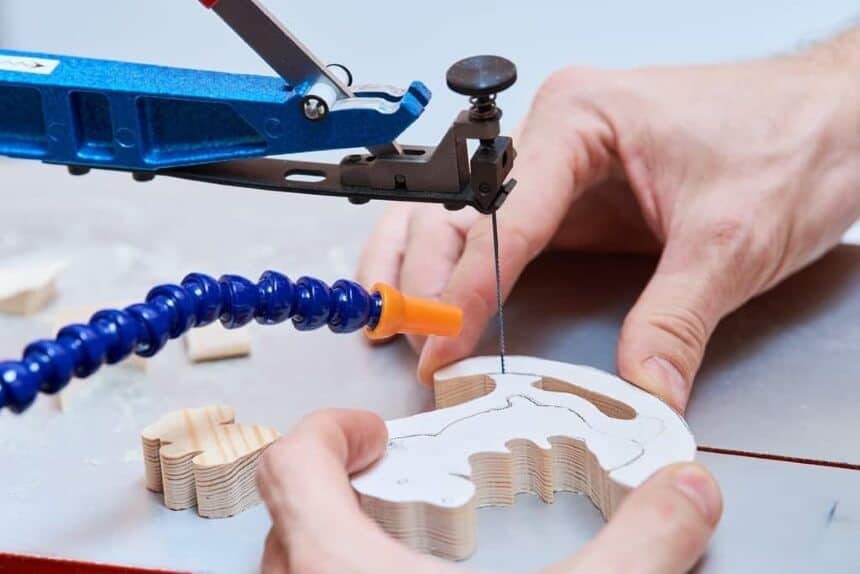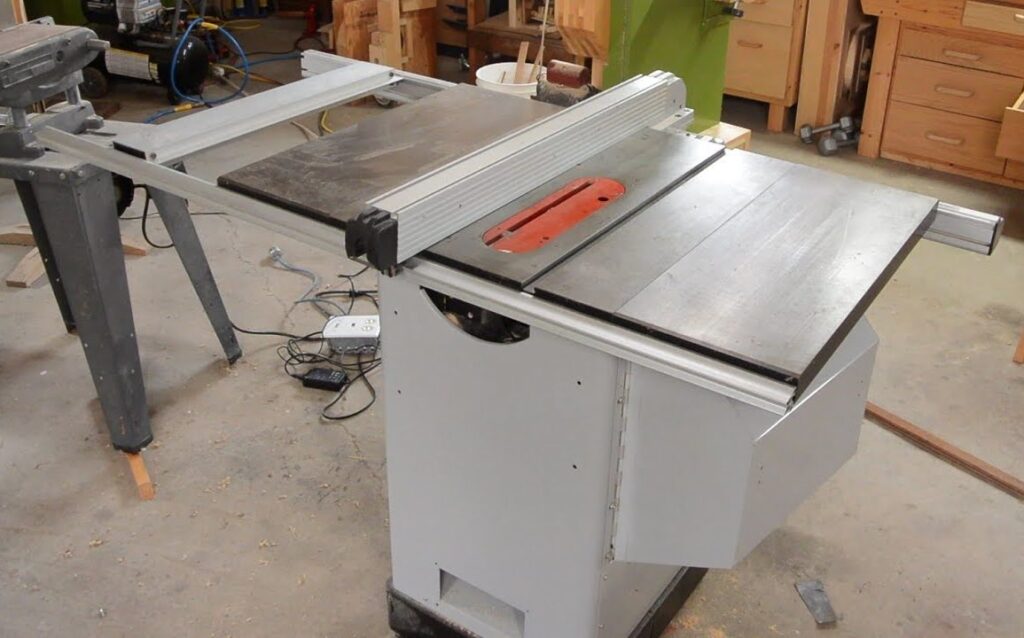A scroll-saw is the ‘It’ fine-detail tool for hobbyists, woodworkers, and crafters. This is primarily because its thin blade allows the creation of intricate designs in different materials, including wood. Knowing how to use a scroll saw makes a whole difference. If you master the technique as a creative, it sets you apart as you will always create beautiful well-thought crafts.
To build your scroll sawing confidence, you can practice by making stuff for your friends. Basically all you have to do is draw your design on wood or metal or whichever material you intend to use, then put on the right gear and cut out the design using your scroll saw. Once you’ve chosen the right speed, you can carefully guide your project through the saw. Read on for more details on how to set and use a scroll saw.

You must be wondering whether beginners and kids can use the tool. Nearly everyone imagines a woodcutting tool when they hear of a scroll-saw. It is safe to use and can cut myriad other materials.
There are different types of scroll-saws, but almost all of them have some standard parts in common, including a flat table, arm, throat, base, and a hole in the table.

A scroll-saw can perform all these functions on a couple of materials, including; wood, plastic, ivory, metals, bone cork, and even mother of pearl.
The DEWALT Scroll Saw is one of the most popular scroll-saws out there. It is a variable-speed scroll-saw with a unique double parallel link arm design that incredibly reduces vibration and noise. Essentially, it offers extremely accurate cuts.
Pro Tip; If you intend to use your scroll-saw on metal, choose a very fine blade, a jeweler’s blade, to be precise, as the regular scroll-saw blade wouldn’t work well.

Standard tooth blade– This is the most basic scroll-saw blade. It has its teeth placed equally far apart. It is deemed the noisiest blade scroll-saw blade.
Skip tooth blade-This is a fantastic option for beginners because it cuts very slowly. It lives up to its name as it has every other tooth missing.
Reverse tooth blade– This a famous go-to for most woodworkers because it prevents tear-out. It is pretty similar to a skip tooth blade but has its last 2 teeth facing upwards or downwards.
Double tooth blade– This is as slow as the skip tooth blade. It has a wide gap after 2 sets of teeth.
Precision ground tooth blade– This is the best you can get for cutting straight lines. As a beginner, you ant to stay away from this blade as it is very unforgiving. The blade has smaller teeth, and instead of filing, it is ground down.
Spiral blade– this has teeth on all sides, allowing you to make cuts in all directions. However, it can be challenging to use, and it doesn’t give clean cuts.
Crown tooth blade– This is what you should get for cutting plastic. It has every second tooth pointing in the opposite direction.
Here is how to use a Dremel 16 scroll-saw or any other model of scroll-saw out there:
Draw your desired pattern on the wood, metal, plastic, or material of choice. You can use a pencil as long as it is visible on the material. Create bridges on the pattern and ensure you leave positive and negative space for convenience when you make the cut. If you don’t know how to draw a scroll-saw pattern, you can get some online.

Secure the scroll-saw correctly on your work surface. If you don’t know how to bolt, screw or clamp it to the surface, you can refer to the manufacturer’s instructions.
Pick an appropriate blade for your project. Remember, the lower the number of the blade, the smaller it is. If you will be cutting through thin material or cut intricate designs, choose a smaller blade. A smaller blade will also cut slowly, allowing you to have more control.
For thicker material, use a larger blade. The higher the number of the blade, the better its capability to cut through thick material.
Once you have picked the correct blade and fitted it, follow the manufacturer’s instructions to set its tension. You can check if you have set the tension correctly using your finger to apply moderate pressure to the blade’s middle part. If it moves more than 3mm in either direction, then you haven’t set the tension right. In the right tension, the blade won’t cave or snap.
Plug in the saw and turn on the power switch. Turn the light on as well so you can see your project. If the scroll-saw has a dust blower, turn it on as well to remove the dust from your work.
Test the scroll-saw by cutting a scrap material. Ensure the scrap material is similar to the material you intend to cut. This will let you know if you picked the right blade for the material. You’ll also know if you need to adjust the lighting.
Set the scroll-saw speed. If your material is thin, set the scroll-saw to a slow speed. This is especially important if you are a beginner. If you are cutting wood and it is softwood, you can increase the scroll saw’s speed. What’s more, as a beginner, you want to go for a variable speed scroll-saw so that you can have full control. The Delta Power Tools 40-69 scroll saw is of the best-rated scroll-saws with variable speed out there. It offers a wide array of cutting applications with its impressive 400-1750 SPM electronic variable speed.

When you are done cutting your project, and you are happy with how it looks, turn off the scroll-saw. Remove the project from the working surface, then unplug the machine and detach it from the workbench before storing it.
Scroll-saws can be used by kids and beginners with keen adherence to safety measures during use. The safety tips will prevent accidents which are highly likely to occur as a scroll-saw is a cutting machine. They include:
· Get a safe work area. Scroll-saws produce a lot of dust, and so you need to use one in a well-ventilated area. Also, keep the scroll-saw at a 2-ft perimeter away from people, pets, or debris.
· Scrutinize your scroll-saw before turning it on and ensure it is secured safely on your workbench or tabletop.
· Ensure the power is off when you are making any adjustments.
· Use the correct speed, blade type, and blade tension for your projects.
· Don’t start the machine before checking that all the handles are locked.
· DO NOT reach under the table when the machine is on.
· Keep your fingers away from the blade.
There’s no better tool to use for adding a delicate touch to your craft than the scroll-saw. Using a scroll saw requires great patience and a special kind of keenness to details. Once you learn how to use a scroll saw, you will realize how incredibly satisfying it is, given it can do a couple of marvelous things. We have provided all the information about scroll-saws and their functionality. You wouldn’t even need to read books on how to use scroll-saws.
If you are new to using scroll-saws, ensure you understand the different types of blades for top precision in your projects. Once you have your blade right, everything else is pretty much straightforward as long as you follow the manufacturer’s instructions and adhere to the safety tips.





